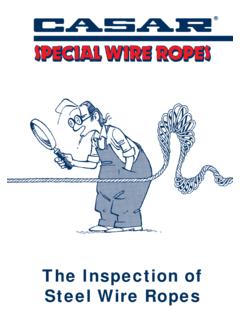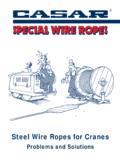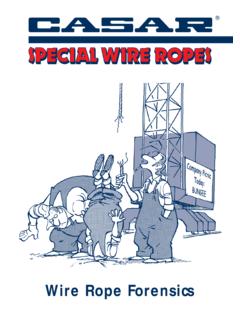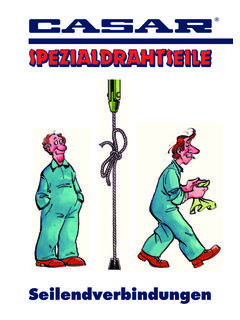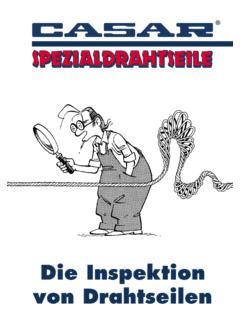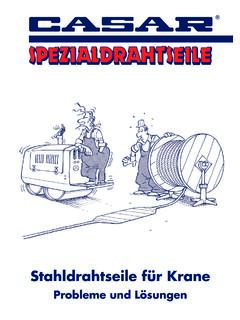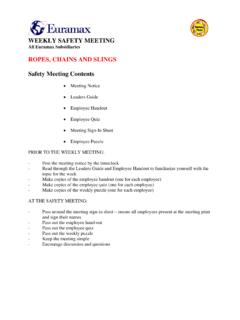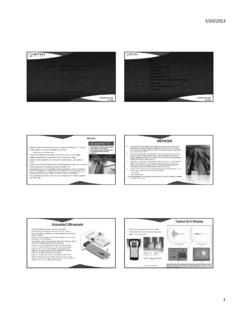Transcription of A new method for detecting wire rope defects
1 OIPEEC Conference - Athens - March 2006 55 R. Verreet ODN 0771 wire rope Technology Aachen, Aachen, Germany A new method for detecting wire rope defects Abstract wire ropes are very regular machine elements. Any deviation from the regular rope pattern can be used to determine defects resulting from the rope manufacture, from the installation procedure or from rope deterioration during service. This paper describes a novel method for detecting defects and changes in the wire rope geometry. 1 Introduction From a safety point of view, the first wire rope in history, manufactured in 1834 by the German mining engineer Wilhelm August Julius Albert, had a great advantage over all other steel wire rope designs that were developed later: it did not have a metal core, and it did not have wires inside its strands (Figure 1).
2 Therefore, during a visual inspection, every single wire of the rope could be inspected. Figure 1: Cross section of the Albert rope . Every wire can be visually inspected. In steel wire ropes manufactured today, however, a great percentage of the metallic area cannot be visually inspected at all. In a rope 36 7, as an example, the steel core, which cannot be visually inspected, accounts for about 50% of the metallic area (Figure 2). The outer strands make up the remaining 50%. But even here, the centre wires cannot be visually inspected either.
3 They are covered by another layer of wires (Figure 3). Trends for Ropes 56 Figure 2: Cross section of a rope 36 7. The core, which makes up about 50% of the metallic area of the rope , cannot be visually inspected. Figure 3: Cross section of a rope 36 7. The centre wires of the outer strands, which make up about 10% of the metallic area of the rope , cannot be visually inspected. The only wires which can be visually inspected are the outer wires of the rope . These represent about 40% of the metallic cross sectional area.
4 But even these wires disappear inside the rope on about half of their lengths, leaving only about 20% of the rope s cross section accessible for a visual inspection (Figure 4). Figure 4: The outer wires, which make up about 40% of the rope , can only be inspected on about half of their lengths. Similar percentages will be obtained for most other ropes with a steel core. Because you can only visually inspect such a small percentage of the steel wire rope cross section, visual rope inspections must be performed with great care.
5 But even then a great uncertainty about the overall condition of the wire rope remains: Visual rope inspection = 20% evidence + 80% hope OIPEEC Conference - Athens - March 2006 57 In order to also gain information about the remaining 80% of the steel wire rope cross section, non destructive (magnetic) test methods have been developed. In many applications, such NDT tests are mandatory and performed at regular intervals, every 6 months. But what happens in the long period between those NDT tests? Rock fall might damage a mining rope one day after the magnetic inspection and create a safety critical rope condition.
6 Therefore, visual wire rope inspections must still be carried out daily. Now consider the following example: A deep shaft mine is equipped with 4 hoist ropes of a length of 2,000 m each. It also has 8,000 m of balance ropes. A visual inspection would therefore have to be done on 16,000 m of rope . If the inspector would spend only two seconds on every rope metre, the inspection of the 16,000 m of rope would take 9 hours. Of course, during such an inspection, the shaft could not operate. The visual rope inspection would therefore cost the mine a few 100,000 Dollars in downtime.
7 Of course, the mine could place 4 inspectors next to each other, everyone of them inspecting one of the ropes. This would reduce the inspection time to 2 hours, but even that would cost a fortune. 2 The new test method This paper is going to present a method which in the future will allow regular visual rope inspections at normal operating speeds and without any downtime costs. Strands Steel wire strands are very regular bodies. Their geometry repeats itself after every lay length. 1000 photographs of a brand new and undamaged strand taken at distances of exactly one strand lay length should therefore all look identical (Figure 5).
8 A cinema projector playing these 1000 photos in a sequence should therefore produce a static, not changing image. This would be a boring movie, I admit. But it would tell me that the strand is not damaged externally. Now think of the same strand, but with a few defects . Now 1000 photographs taken at distances of exactly one strand lay length will no longer all look identical: Some pictures will be different (Figure 6). And a cinema projector playing these 1000 photos in a sequence will now produce a static image where from time to time objects will flash, making it easy to locate the strand lays which have an external defect.
9 Trends for Ropes 58 Figure 5: Pictures of a brand new strand taken at steps of one lay length would all look identical. Figure 6: Pictures of a damaged strand taken at steps of one lay length would no longer look identical. OIPEEC Conference - Athens - March 2006 59 With a strobe light flashing at the correct speed or, even better, with a flash light triggered by a lay length or speed sensor, this effect can easily be studied: Although travelling at high speed, the strand seems to stand still, and only from time to time an abnormality ( a wire break) produces a short flash.
10 These high speed pictures can be recorded in different ways for later, more thorough examination of the defect areas, or in order to let a computer find these defects in the first place. One method of how this could be done is explained here: If you superimpose a positive black and white image of one lay length with the negative black and white image of the next (and identical) lay length, the result will be a black image (Figure 7). A cinema projector playing 1000 such superimposed photos in a sequence should therefore produce a dark screen only.
